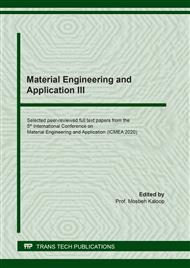[1]
T. Hara, Y. Ishizawa, D.G. Hemmes, R.S. Rosler, High temperature stability of plasma-enhanced chemically vapour deposited titanium silicide due to two-step rapid thermal annealing, Thin Solid Films 157 (1988) 135-142.
DOI: 10.1016/0040-6090(88)90354-9
Google Scholar
[2]
P. Osiceanu, An XPS study on ion beam induced oxidation of titanium silicide, Applied Surface Science 253 (2006) 381–384.
DOI: 10.1016/j.apsusc.2006.06.018
Google Scholar
[3]
R. Rosenkranz, G. Frommeyer, W. Smarsly, Microstructures and properties of high melting point intermetallic Ti5Si3 and TiSi2 compounds, Materials Science and Engineering A152 (1992) 288-294.
DOI: 10.1016/0921-5093(92)90081-b
Google Scholar
[4]
R. Mitra, Mechanical behaviour and oxidation resistance of structural silicides, International Materials Reviews 51(1) (2013) 13-64.
DOI: 10.1179/174328006x79454
Google Scholar
[5]
T. Tamura, M. Li, Influencing factors on the amorphous phase formation in Fe–7.7 at% Sm alloys solidified by high-speed melt spinning, Journal of Alloys and Compounds 826 (2020) 154010.
DOI: 10.1016/j.jallcom.2020.154010
Google Scholar
[6]
P. Urban, E.S. Caballero, F. Ternero, F.J. Viña Reina, F.G. Cuevas, Amorphous phase formation and heat treating evolution in mechanically alloyed Al-Ti, Key Engineering Materials 772 (2018) 118-122.
DOI: 10.4028/www.scientific.net/kem.772.118
Google Scholar
[7]
P. Urban, F.G. Cuevas, J.M Montes, J. Cintas, Effect of boron on the amorphization of Fe-Si alloys by mechanical alloying, Materials Science Forum 730-732 (2013) 739-744.
DOI: 10.4028/www.scientific.net/msf.730-732.739
Google Scholar
[8]
P. Urban, F. Ternero, E.S. Caballero, S. Nandyala, J.M Montes, F.G. Cuevas, Amorphous Al-Ti Powders Prepared by Mechanical Alloying and Consolidated by Electrical Resistance Sintering, Metals 9 (2019) 1140-1153.
DOI: 10.3390/met9111140
Google Scholar
[9]
M. Krasnowski, T. Kulik, Nanocrystalline or amorphous matrix Al60Fe15Ti15(Co/Mg/Zr)5–5%B composites produced by consolidation of mechanically alloyed powders – lightweight materials with high hardness, Intermetallics 28 (2012) 120-127.
DOI: 10.1016/j.intermet.2012.04.011
Google Scholar
[10]
Y.S. Chang, K.T. Hsu, J.B. Li, P.H. Tsai, J.S.C. Jang, J.C. Huang, Effect of cast process and microalloying on the fracture toughness of Zr-based bulk amorphous alloys, Journal of Alloys and Compounds 614 (2014) 87–93.
DOI: 10.1016/j.jallcom.2014.06.062
Google Scholar
[11]
Y. Zhang, J. Zhang, Q. Yan, L. Zhang, M. Wang, B. Song, Y. Shi, Amorphous alloy strengthened stainless steel manufactured by selective laser melting: Enhanced strength and improved corrosion resistance, Scripta Materialia 148 (2018) 20–23.
DOI: 10.1016/j.scriptamat.2018.01.016
Google Scholar
[12]
M. Bulanova, L. Tretyachenko, K. Meleshevich, V. Saltykov, V. Vereshchaka, O. Galadzhyj, L. Kulak, S. Firstov, Influence of tin on the structure and properties of as-cast Ti-rich Ti-Si alloys, Journal of Alloys and Compounds 350 (2003) 164-173.
DOI: 10.1016/s0925-8388(02)00971-4
Google Scholar


